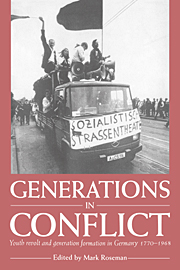Book contents
- Frontmatter
- Contents
- Contributors
- Acknowledgements
- List of abbreviations
- 1 Introduction: generation conflict and German history 1770–1968
- 2 The ideal of youth in late eighteenth-century Germany
- 3 Young Germans and Young Germany: some remarks on the history of German youth in the late eighteenth and in the first half of the nineteenth century
- 4 The battle for the young: mobilising young people in Wilhelmine Germany
- 5 Jewish politics and generational change in Wilhelmine Germany
- 6 The ‘front generation’ and the politics of Weimar Germany
- 7 The New Woman and generation conflict: perceptions of young women's sexual mores in the Weimar Republic
- 8 Generations of German historians: patronage, censorship and the containment of generation conflict 1918–1945
- 9 Gender, generation and politics: young Protestant women in the final years of the Weimar Republic
- 10 The Hitler Youth generation and its role in the two post-war German states
- 11 The BDM generation: a female generation in transition from dictatorship to democracy
- 12 A generation twice betrayed: youth policy in the transition from the Third Reich to the Soviet Zone of Occupation (1945–1946)
- 13 The generation conflict that never was: young labour in the Ruhr mining industry 1945–1957
- 14 The German Kriegskinder: origins and impact of the generation of 1968
- Index
3 - Young Germans and Young Germany: some remarks on the history of German youth in the late eighteenth and in the first half of the nineteenth century
Published online by Cambridge University Press: 19 October 2009
- Frontmatter
- Contents
- Contributors
- Acknowledgements
- List of abbreviations
- 1 Introduction: generation conflict and German history 1770–1968
- 2 The ideal of youth in late eighteenth-century Germany
- 3 Young Germans and Young Germany: some remarks on the history of German youth in the late eighteenth and in the first half of the nineteenth century
- 4 The battle for the young: mobilising young people in Wilhelmine Germany
- 5 Jewish politics and generational change in Wilhelmine Germany
- 6 The ‘front generation’ and the politics of Weimar Germany
- 7 The New Woman and generation conflict: perceptions of young women's sexual mores in the Weimar Republic
- 8 Generations of German historians: patronage, censorship and the containment of generation conflict 1918–1945
- 9 Gender, generation and politics: young Protestant women in the final years of the Weimar Republic
- 10 The Hitler Youth generation and its role in the two post-war German states
- 11 The BDM generation: a female generation in transition from dictatorship to democracy
- 12 A generation twice betrayed: youth policy in the transition from the Third Reich to the Soviet Zone of Occupation (1945–1946)
- 13 The generation conflict that never was: young labour in the Ruhr mining industry 1945–1957
- 14 The German Kriegskinder: origins and impact of the generation of 1968
- Index
Summary
It was in the 1830s and 1840s that ‘youth’ first surfaced as a political slogan in Germany, in the form of the Young Germany movement. But what did the ‘Young’ in Young Germany really mean? Was it just a political programme and rallying cry, around which clustered a variety of democratic goals? Or was it, in fact, a description of the age of those involved, a sign that the youth of Germany was on the march? That many young Germans of the time were influenced by the ideas of Young Germany is not in doubt; not a few suffered police repression as a result. But did Young Germany really embody the will of a whole generation of young people? What were the links between young Germans and Young Germany?
Another way of approaching the phenomenon is comparative. Young Germany was by no means unique on the European scene. In 1831 Giuseppe Mazzini founded the Young Italy movement in Marseille. Three years later in Switzerland, it joined up with Young Poland and Young Germany to form Young Europe. Unaffiliated to this federation there was also a Young France. In Ireland, the Catholic-intellectual Young Ireland proved that the political rallying cry of youth could be fused with a denominational-nationalist movement. All these ‘young’ of Europe were being swept along in a current that would eventually lead them to the revolutionary events of 1848. That was what they had in common. But what were the distinguishing features of Young Germany? Was it inspired by a small and socially uniform avant-garde of intellectuals? Or was it a broad political movement bridging the barriers of social class?
- Type
- Chapter
- Information
- Generations in ConflictYouth Revolt and Generation Formation in Germany 1770–1968, pp. 69 - 91Publisher: Cambridge University PressPrint publication year: 1995
- 1
- Cited by



